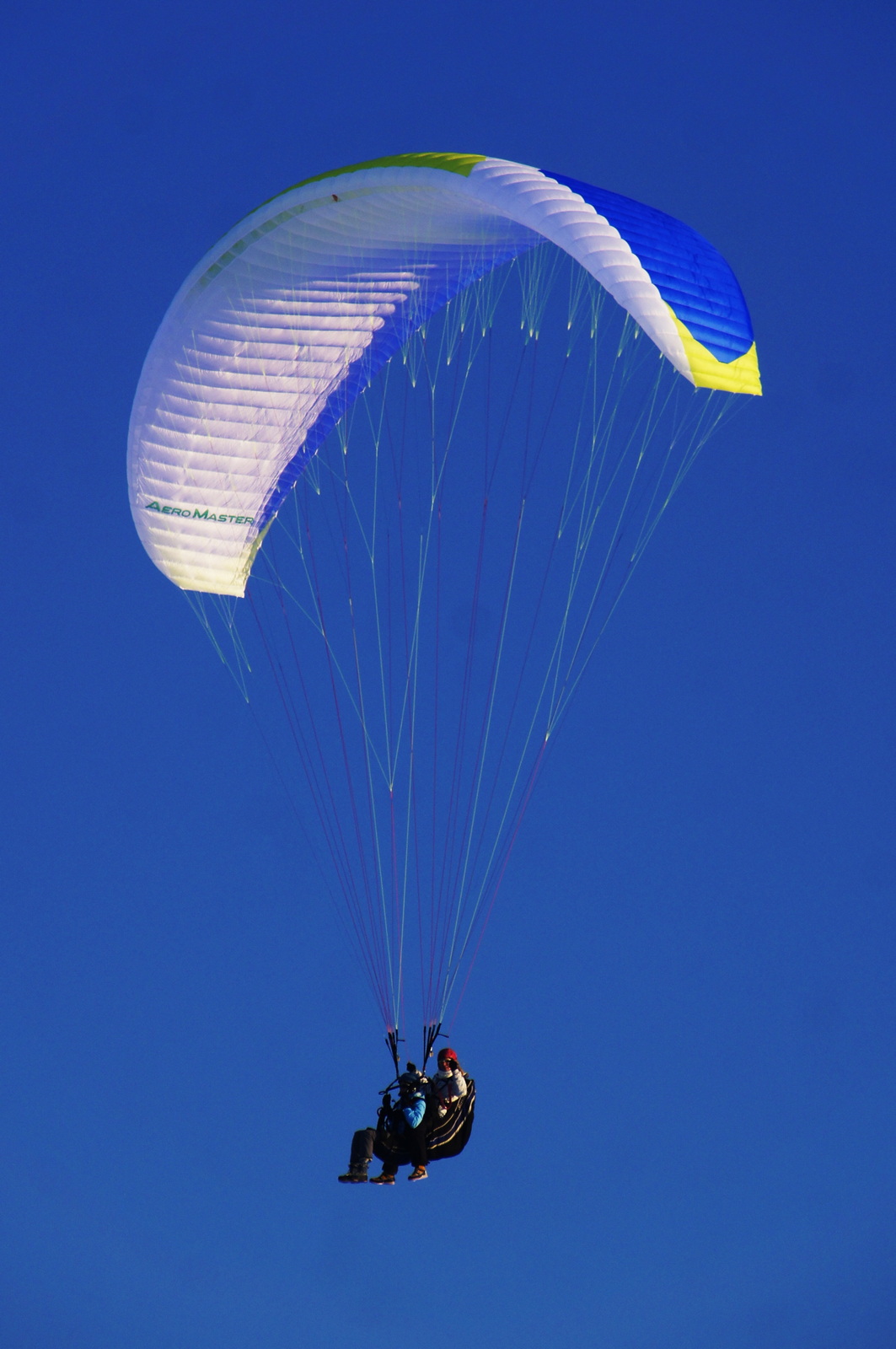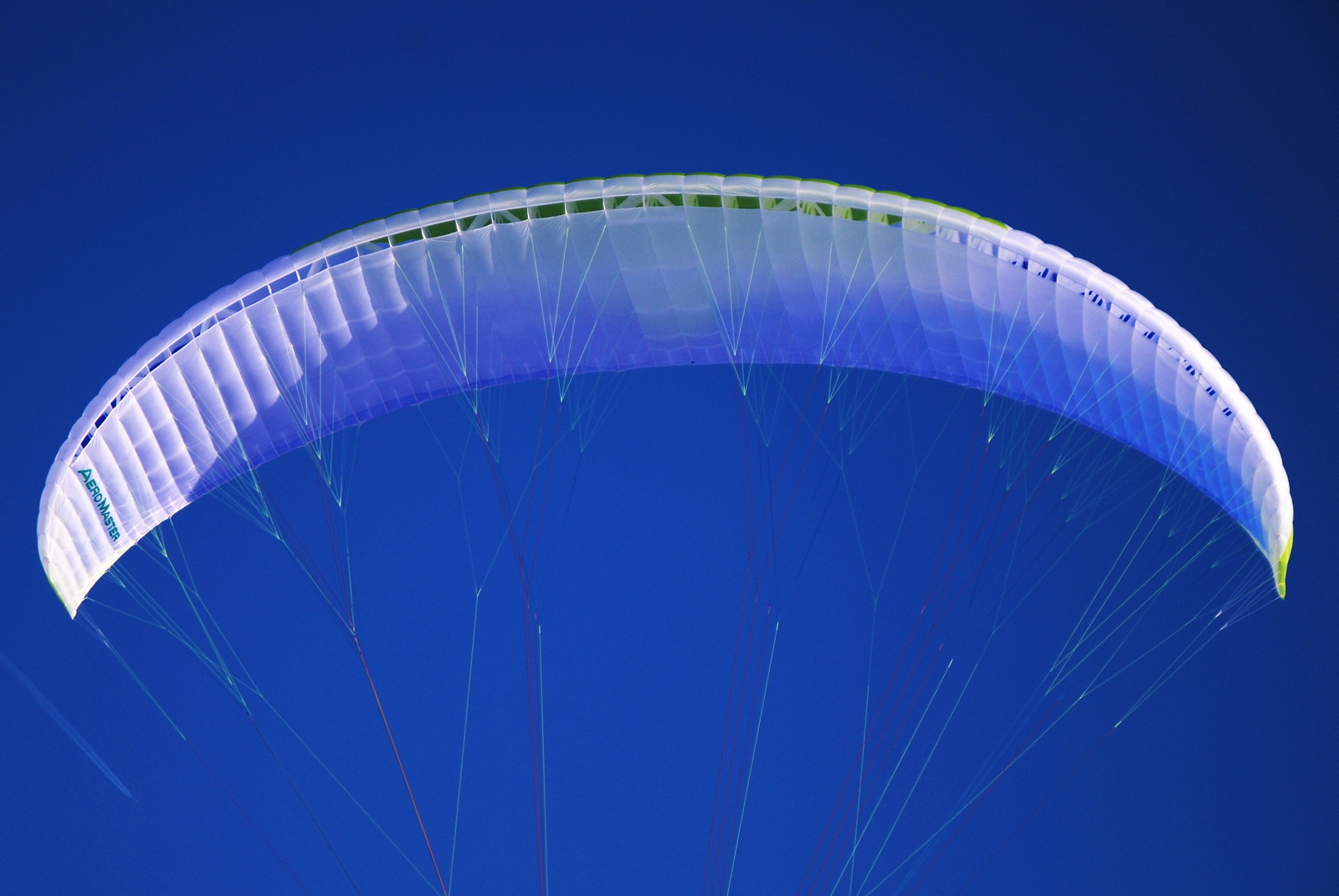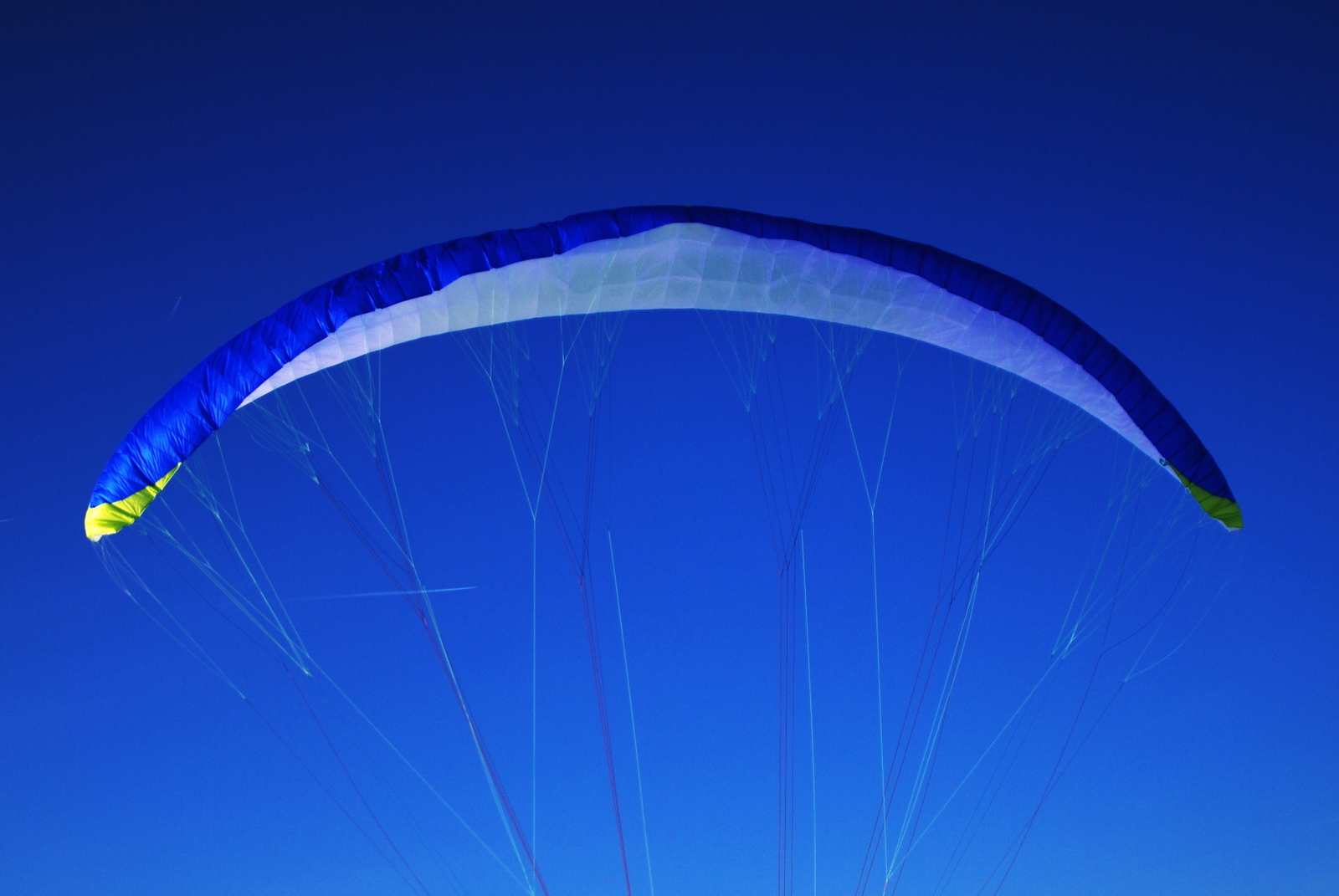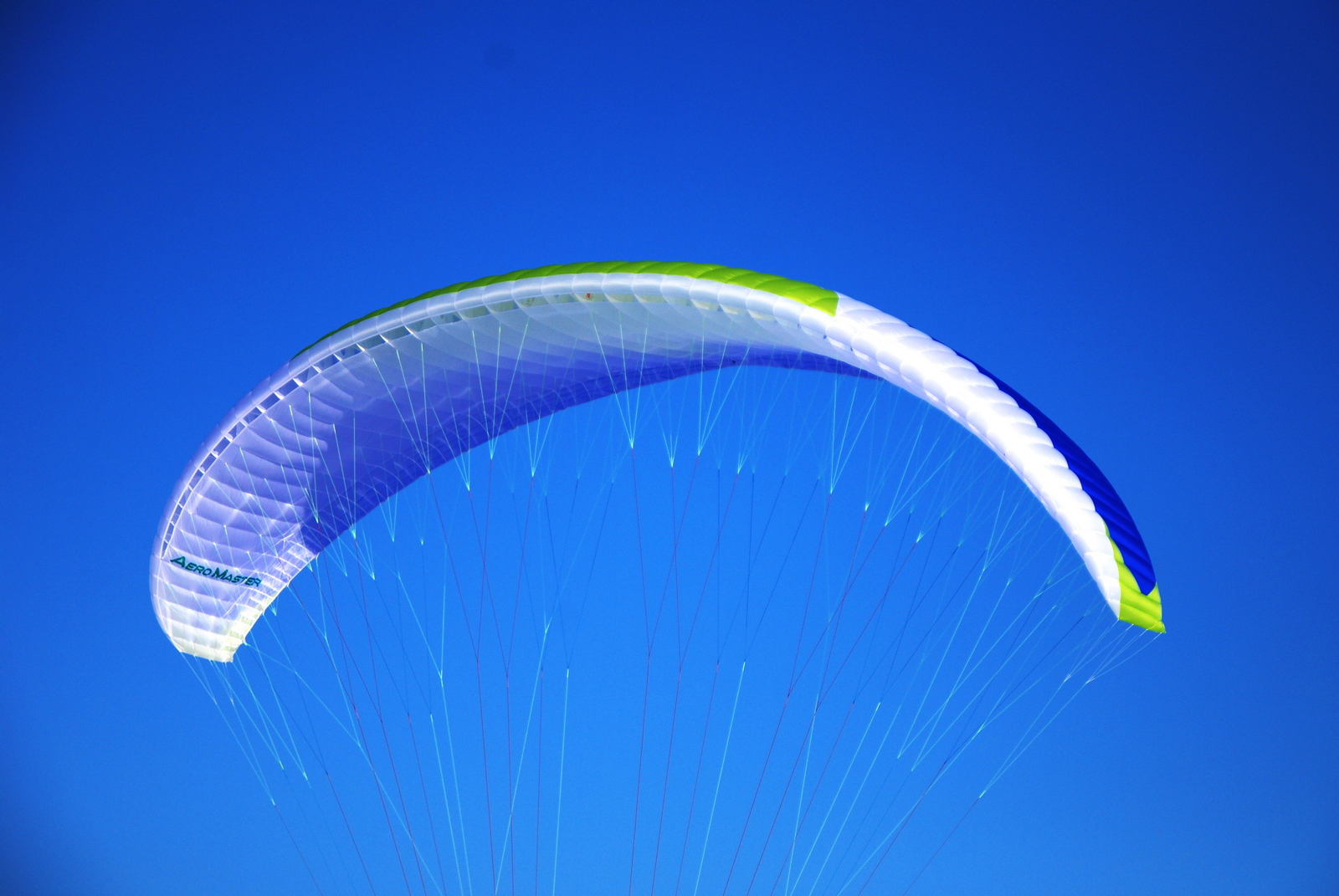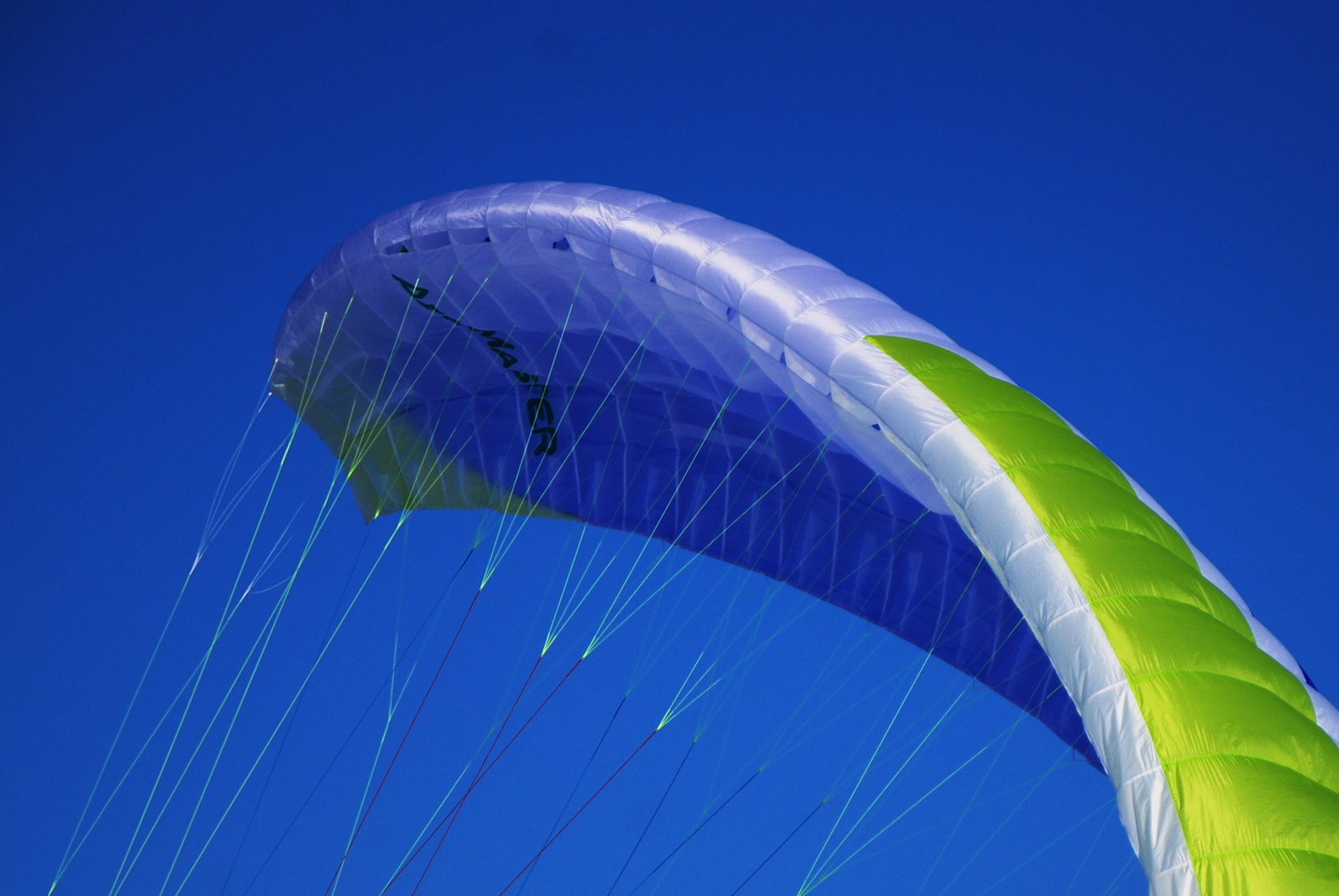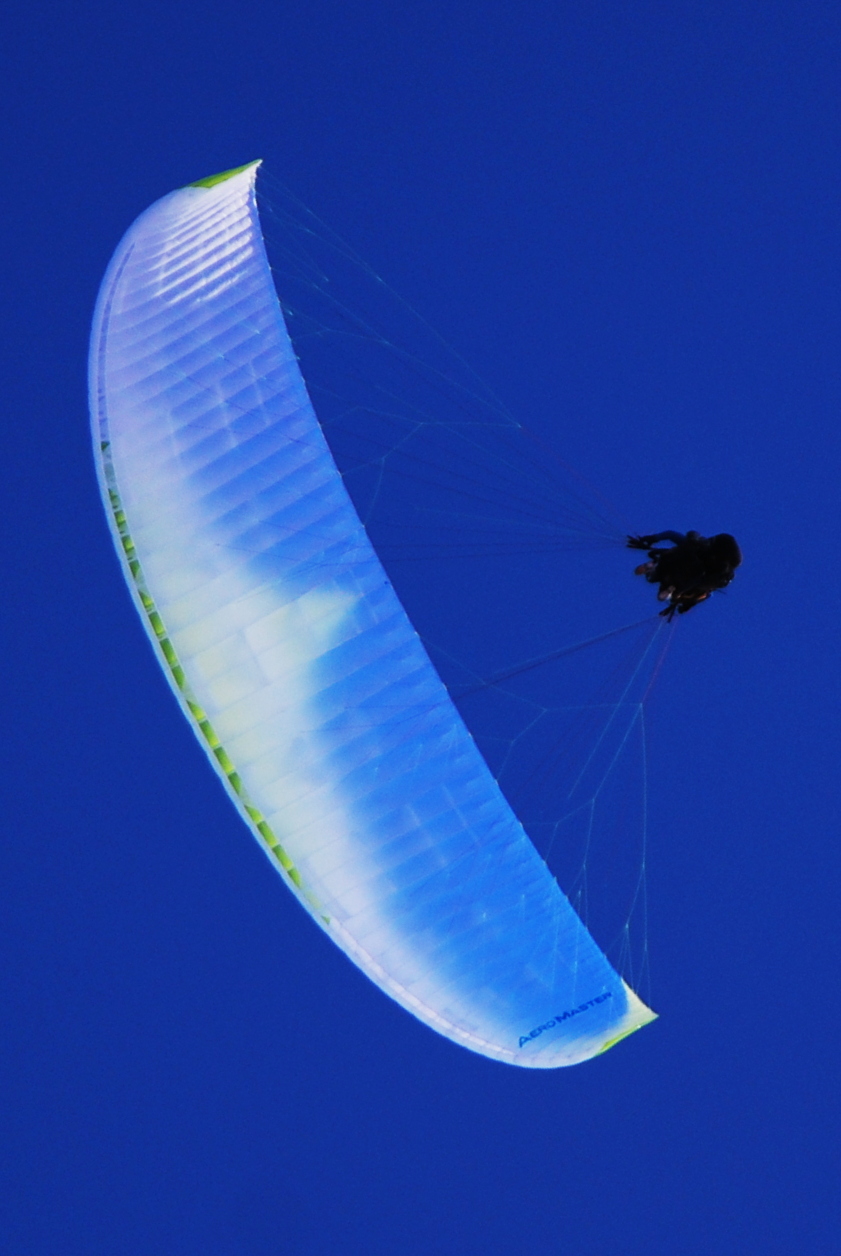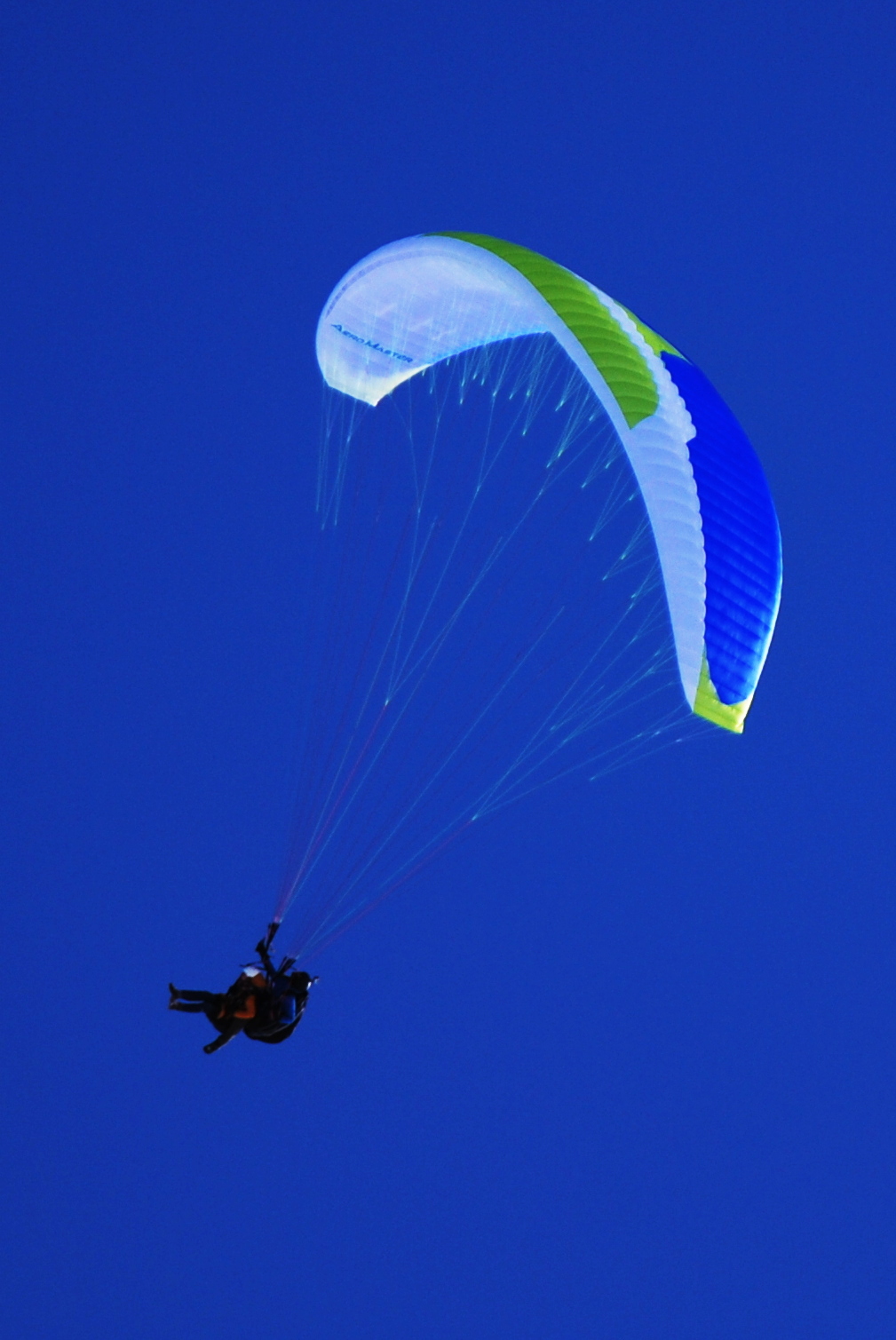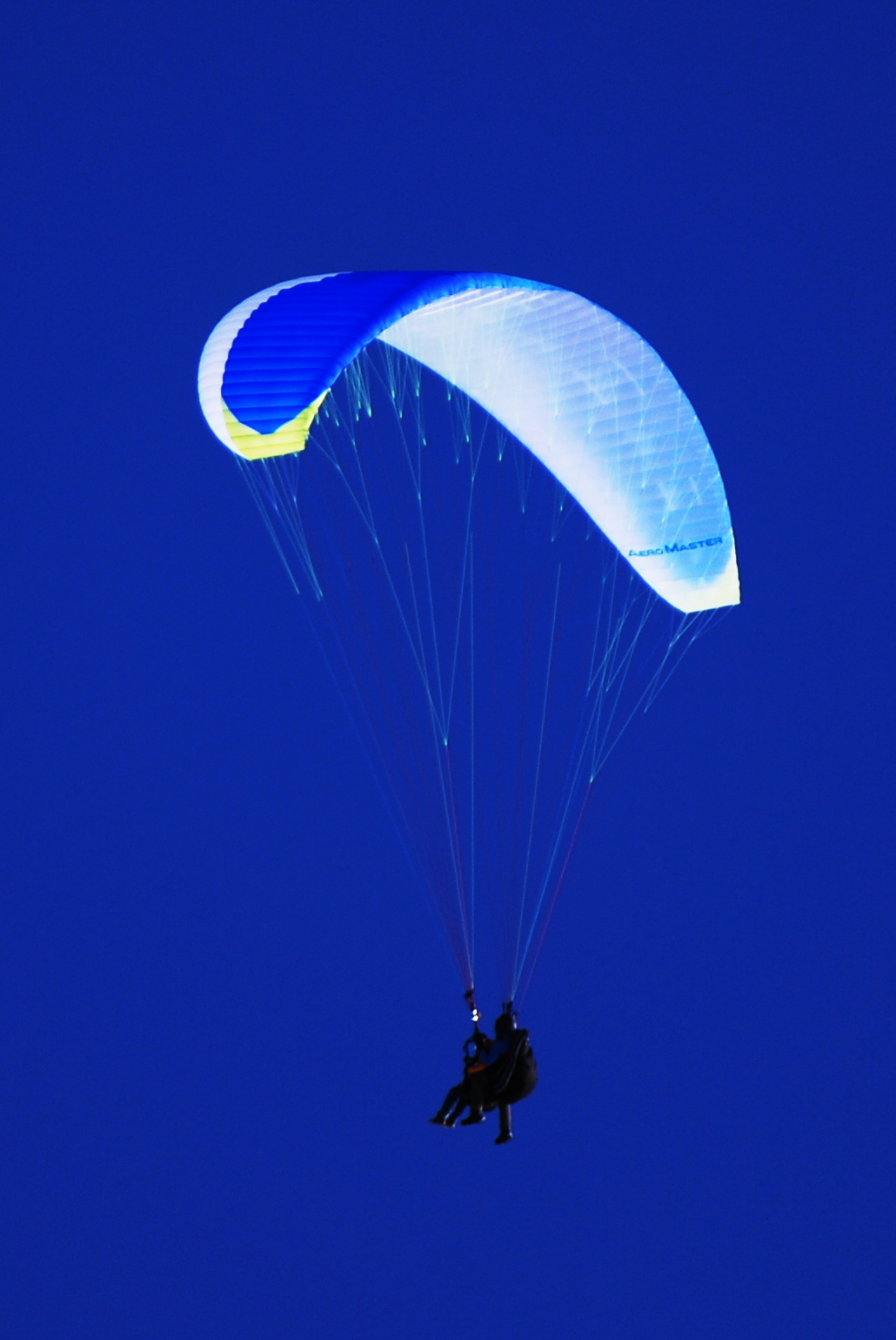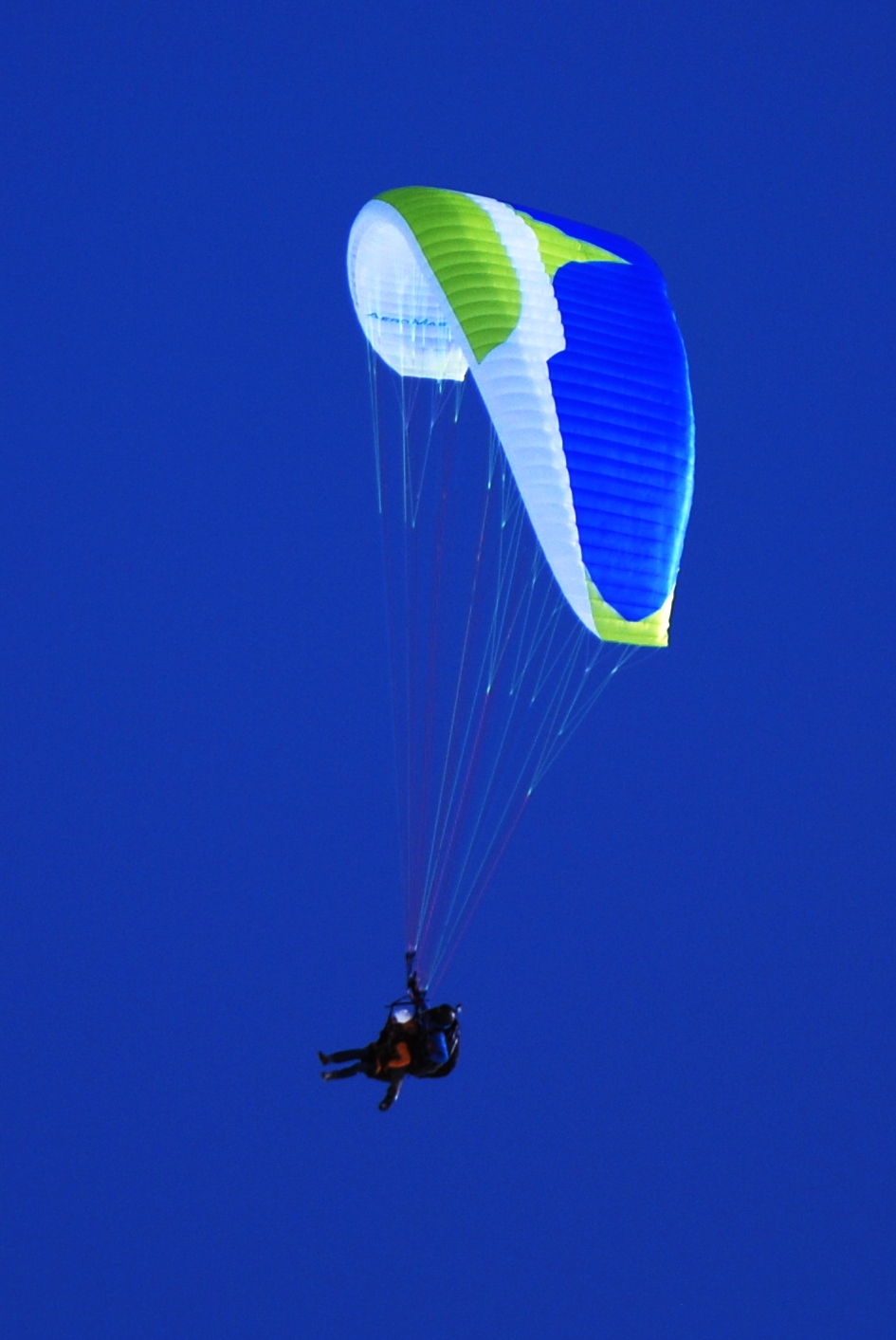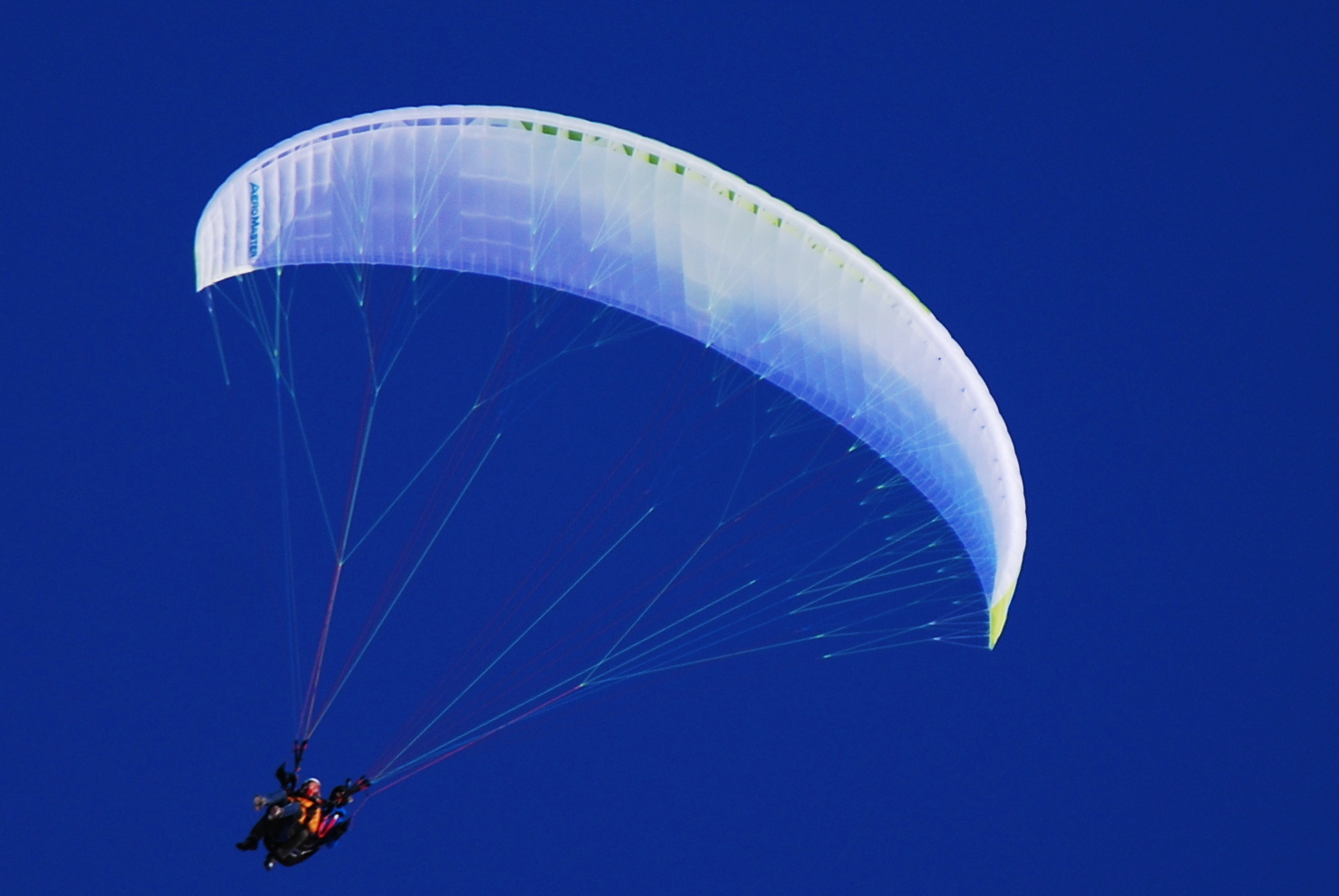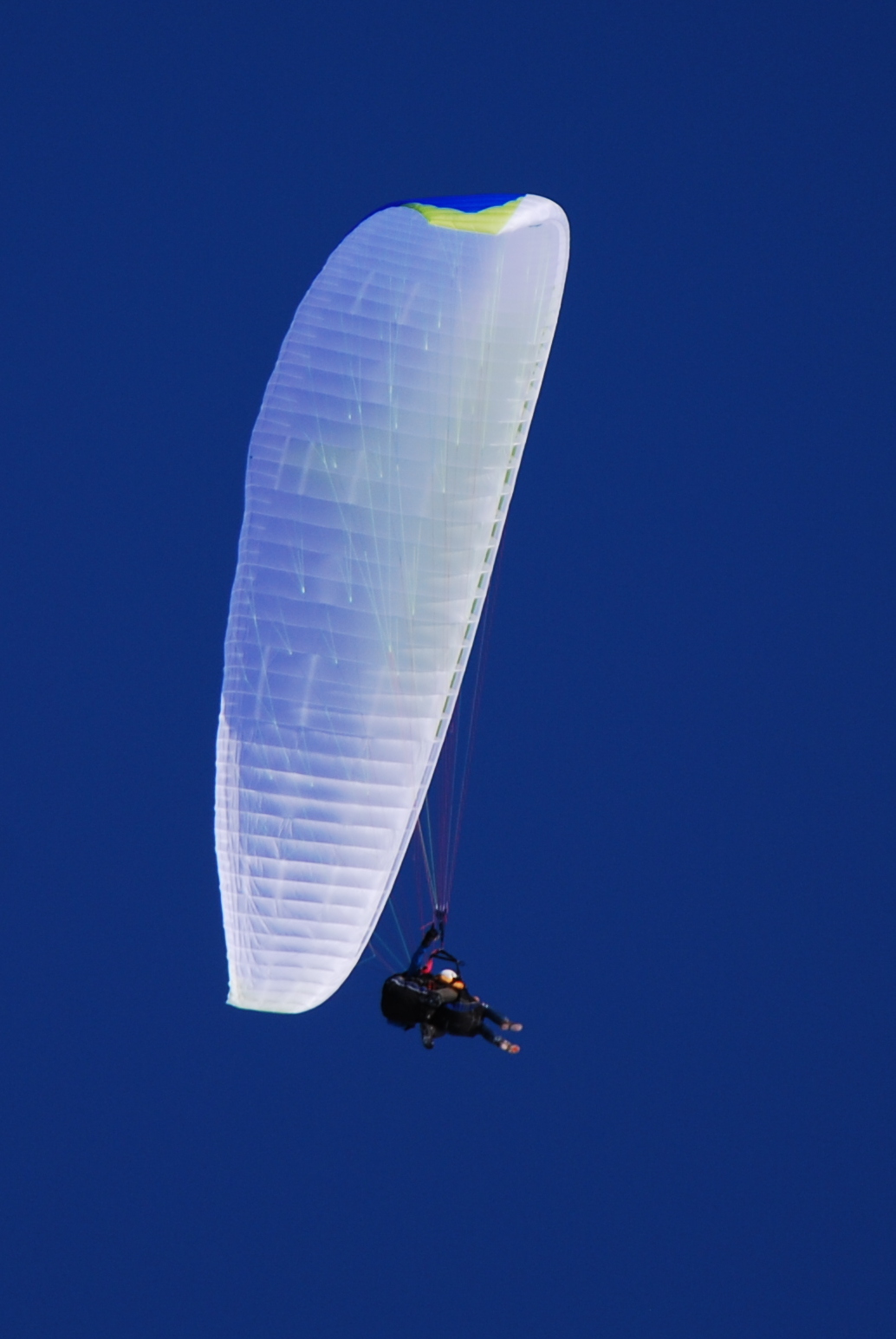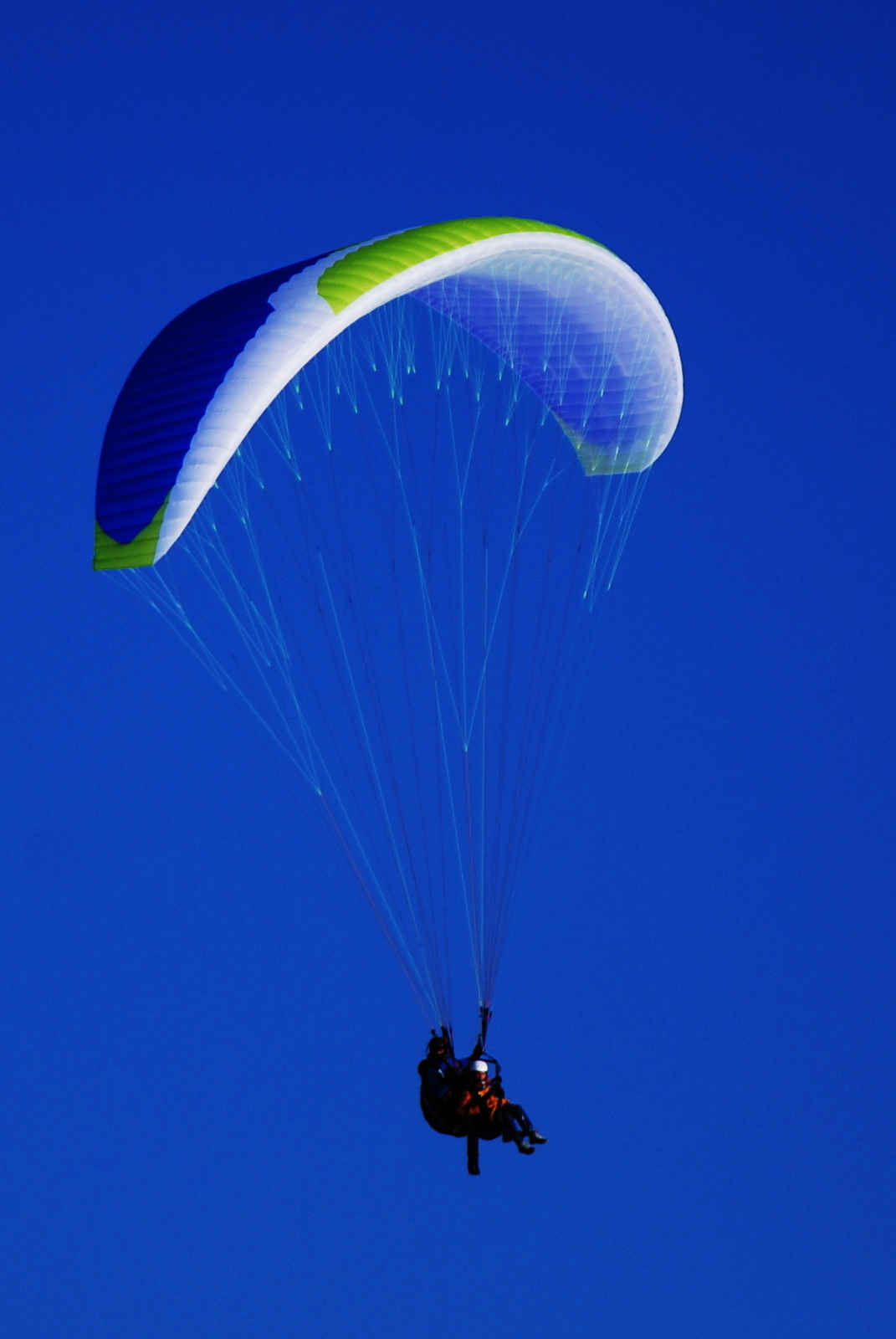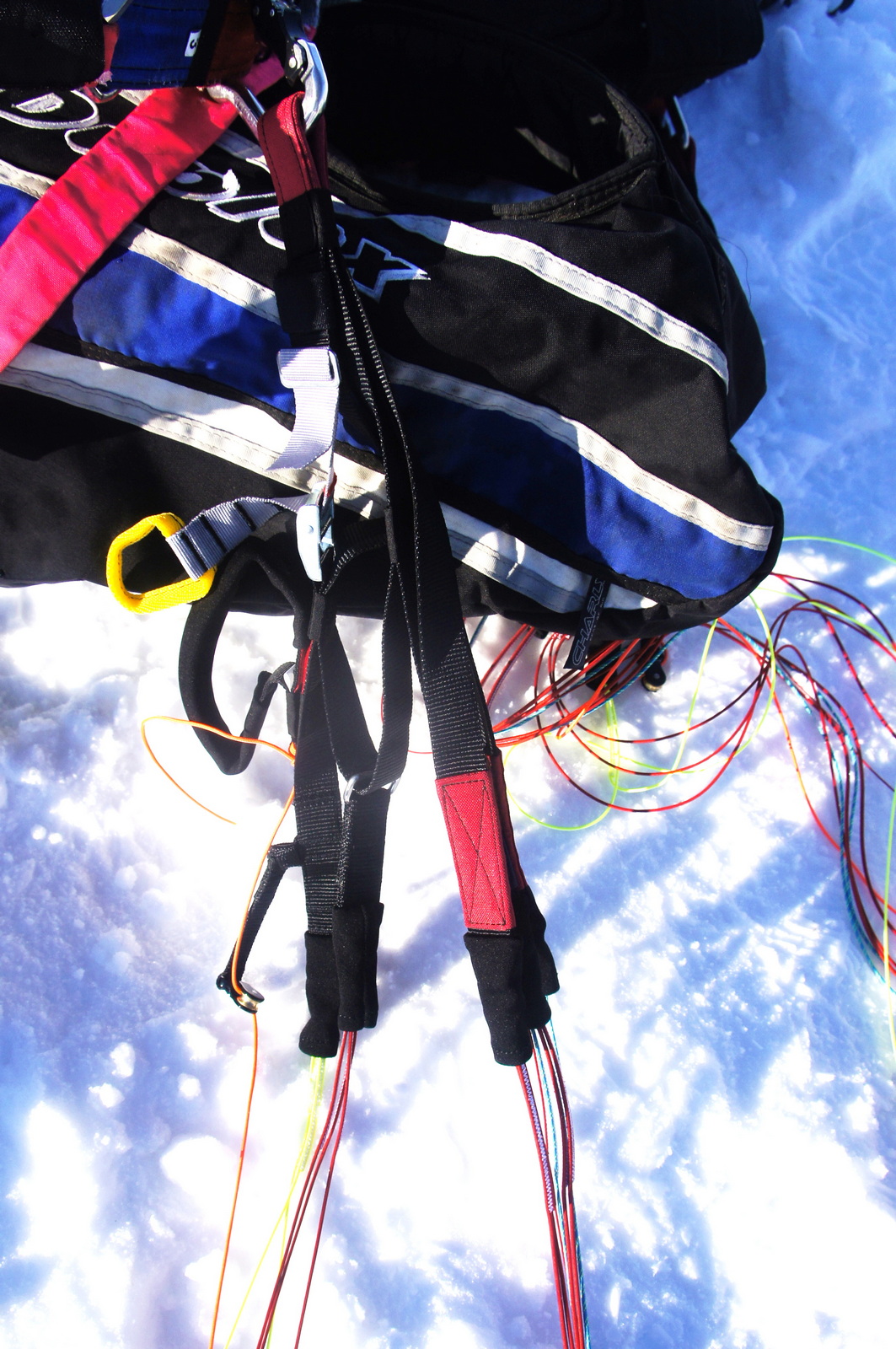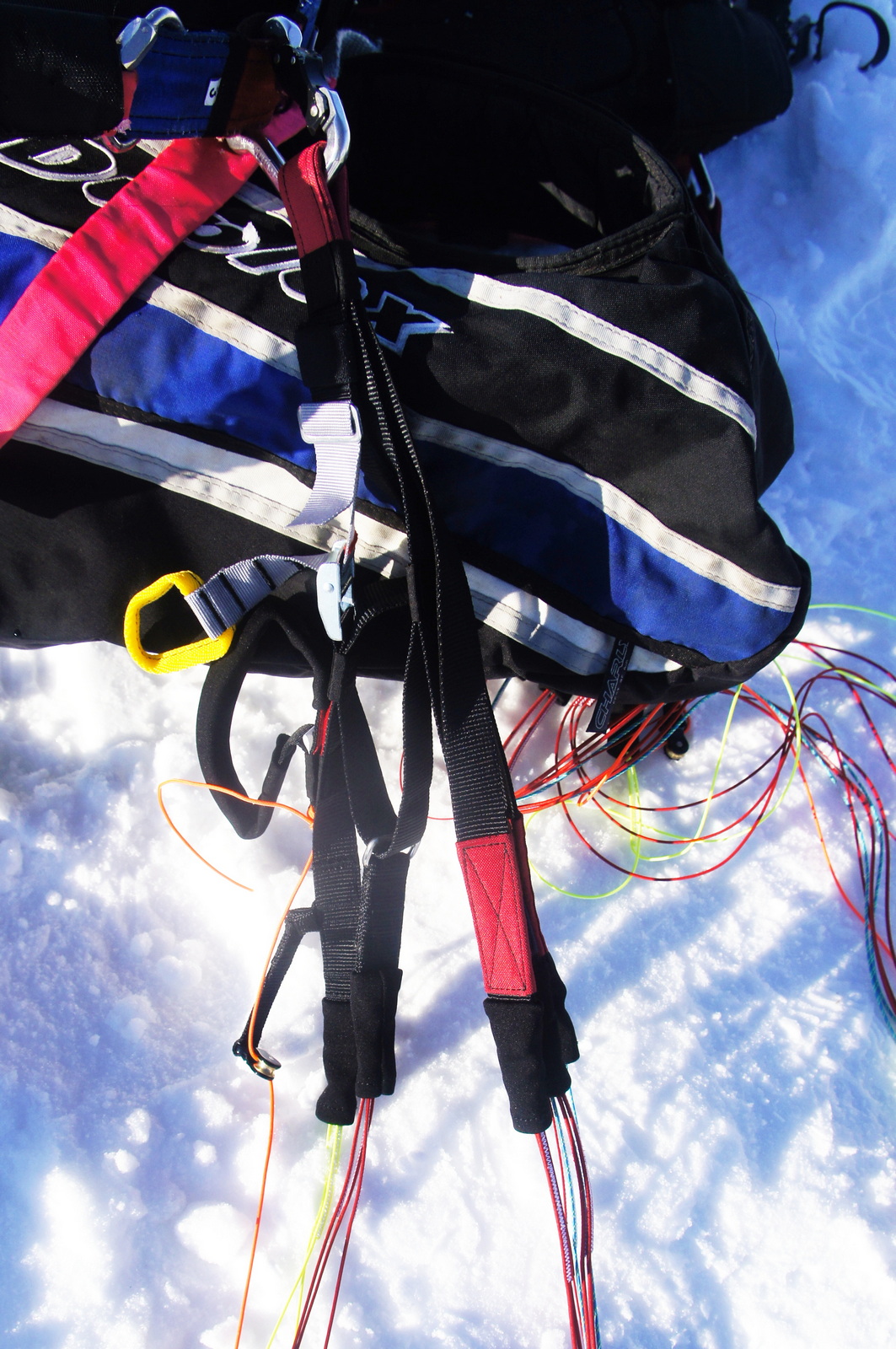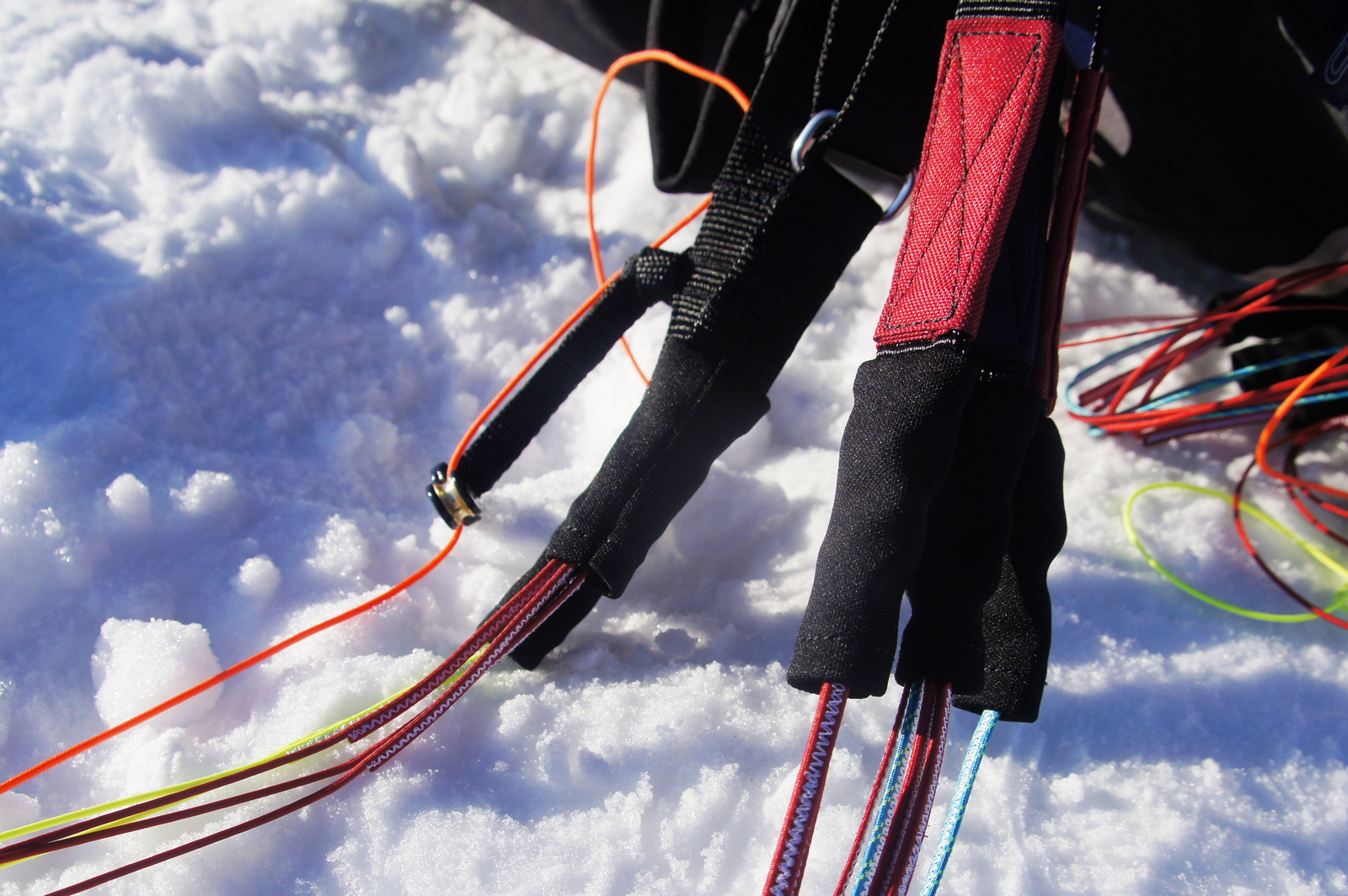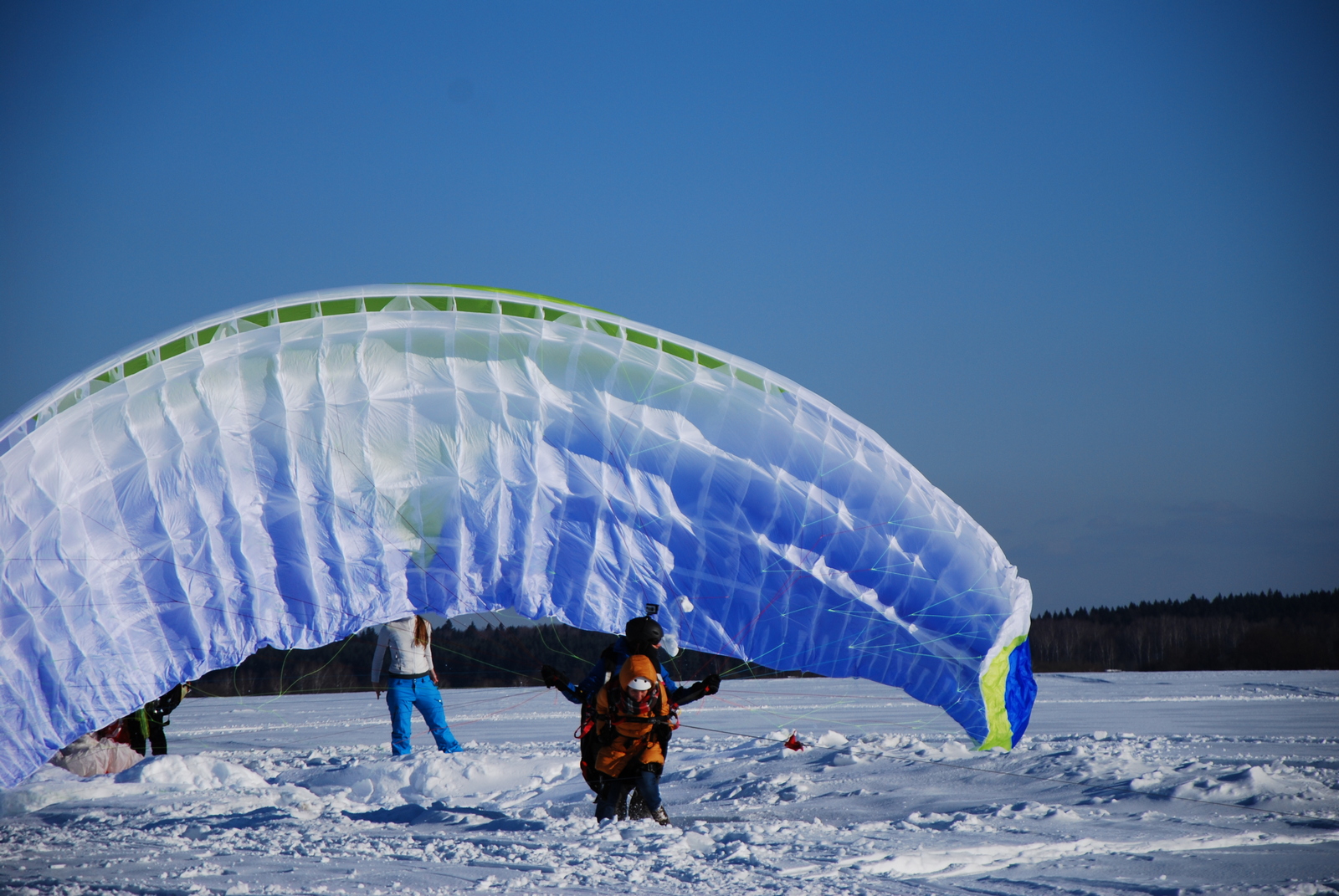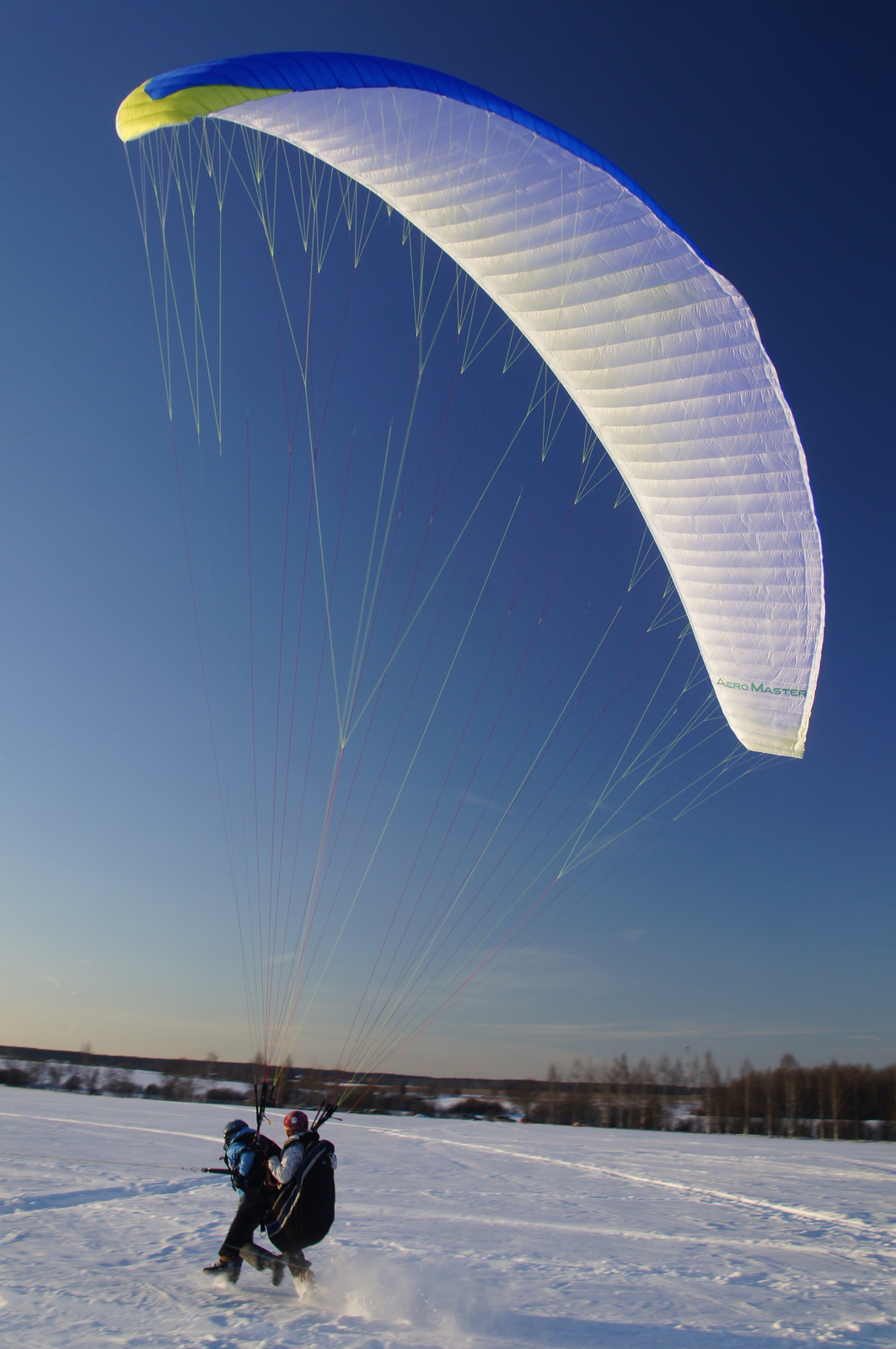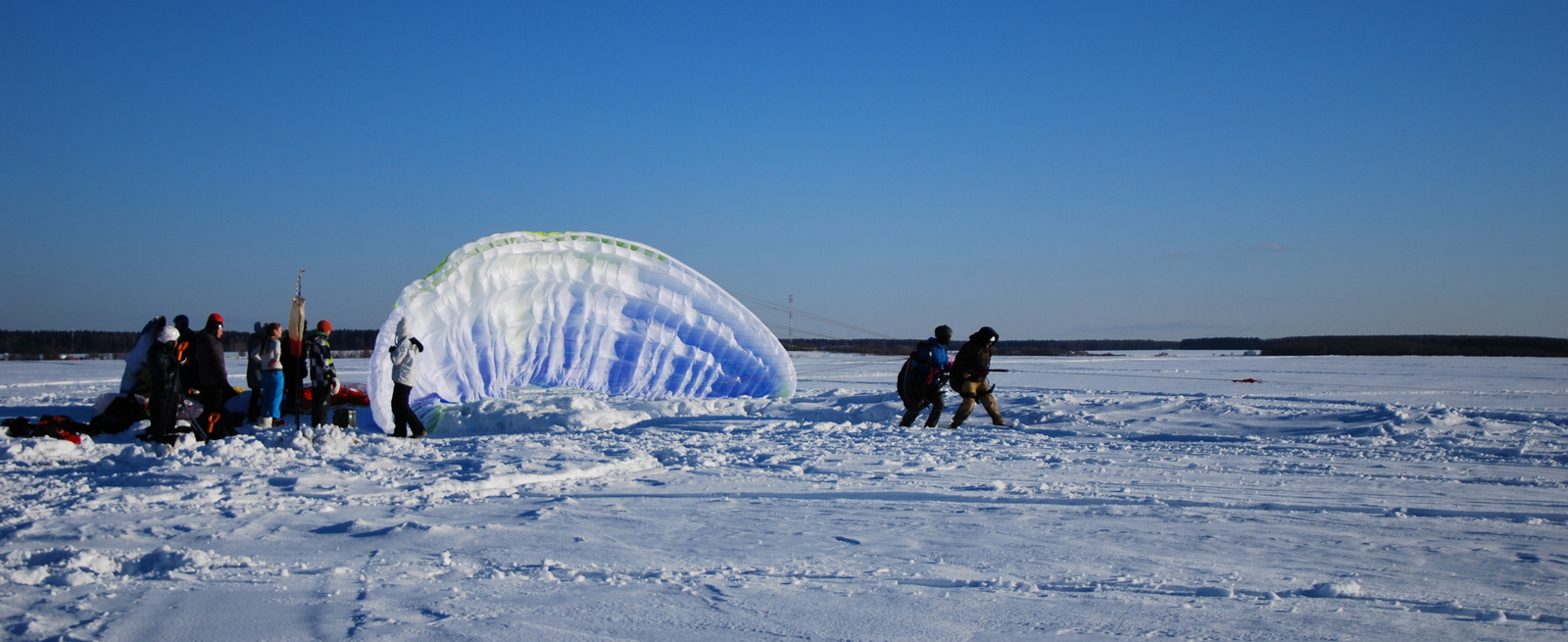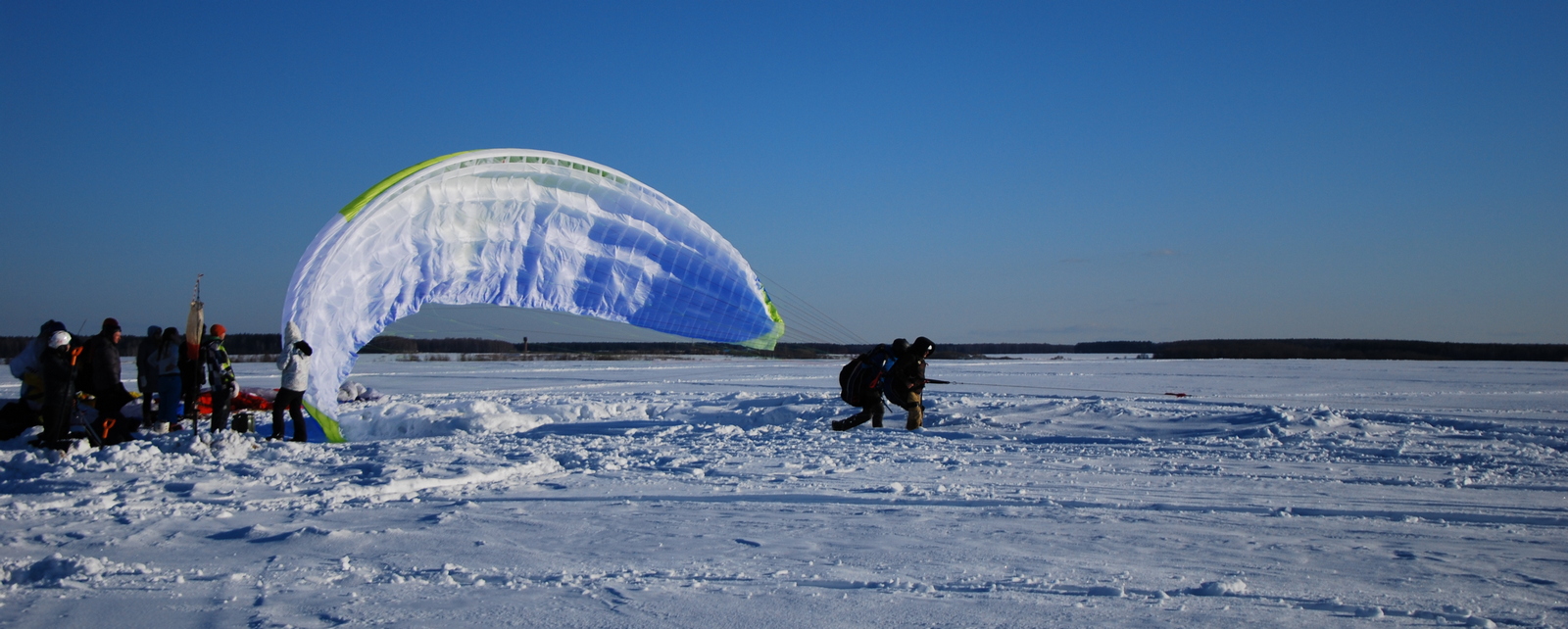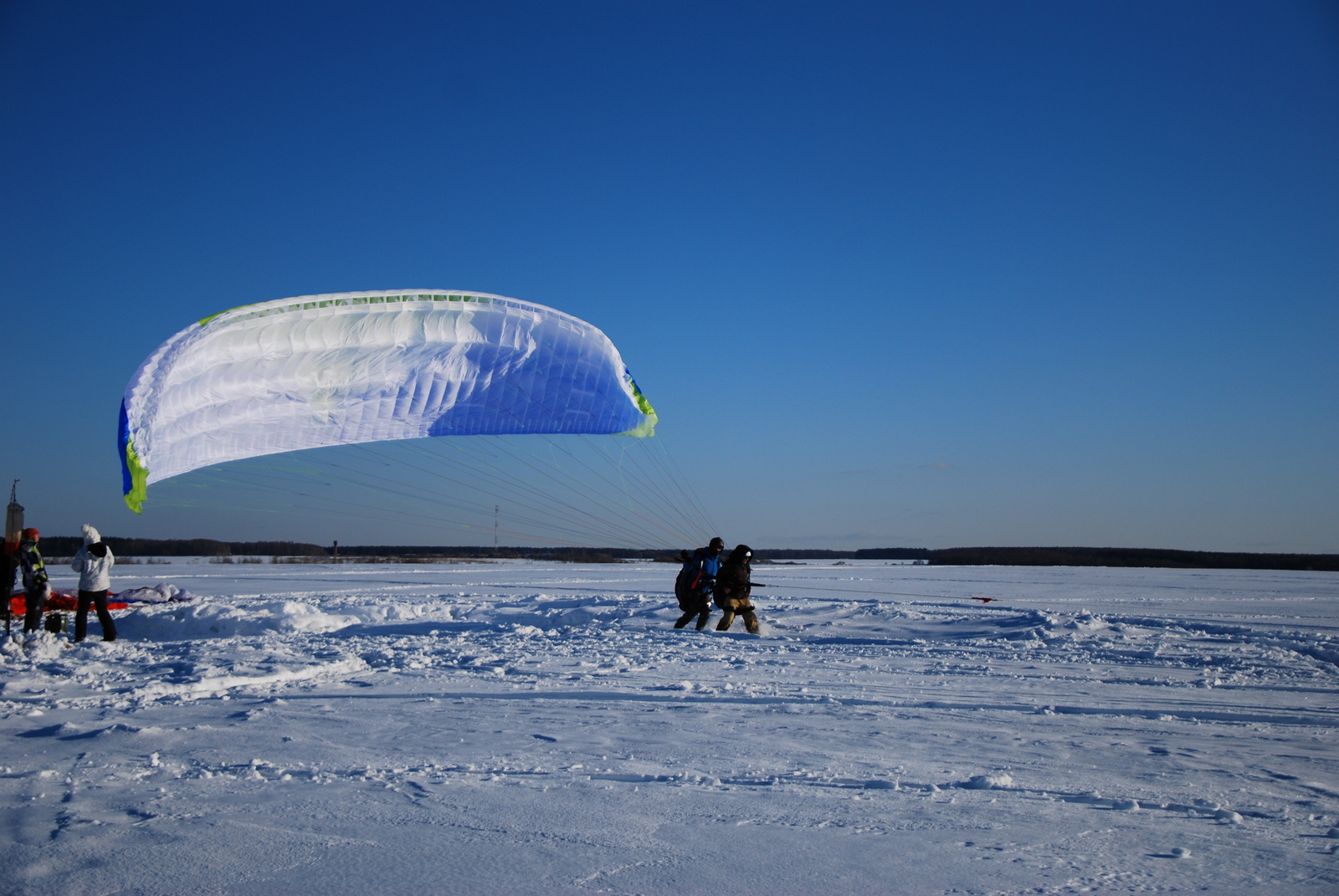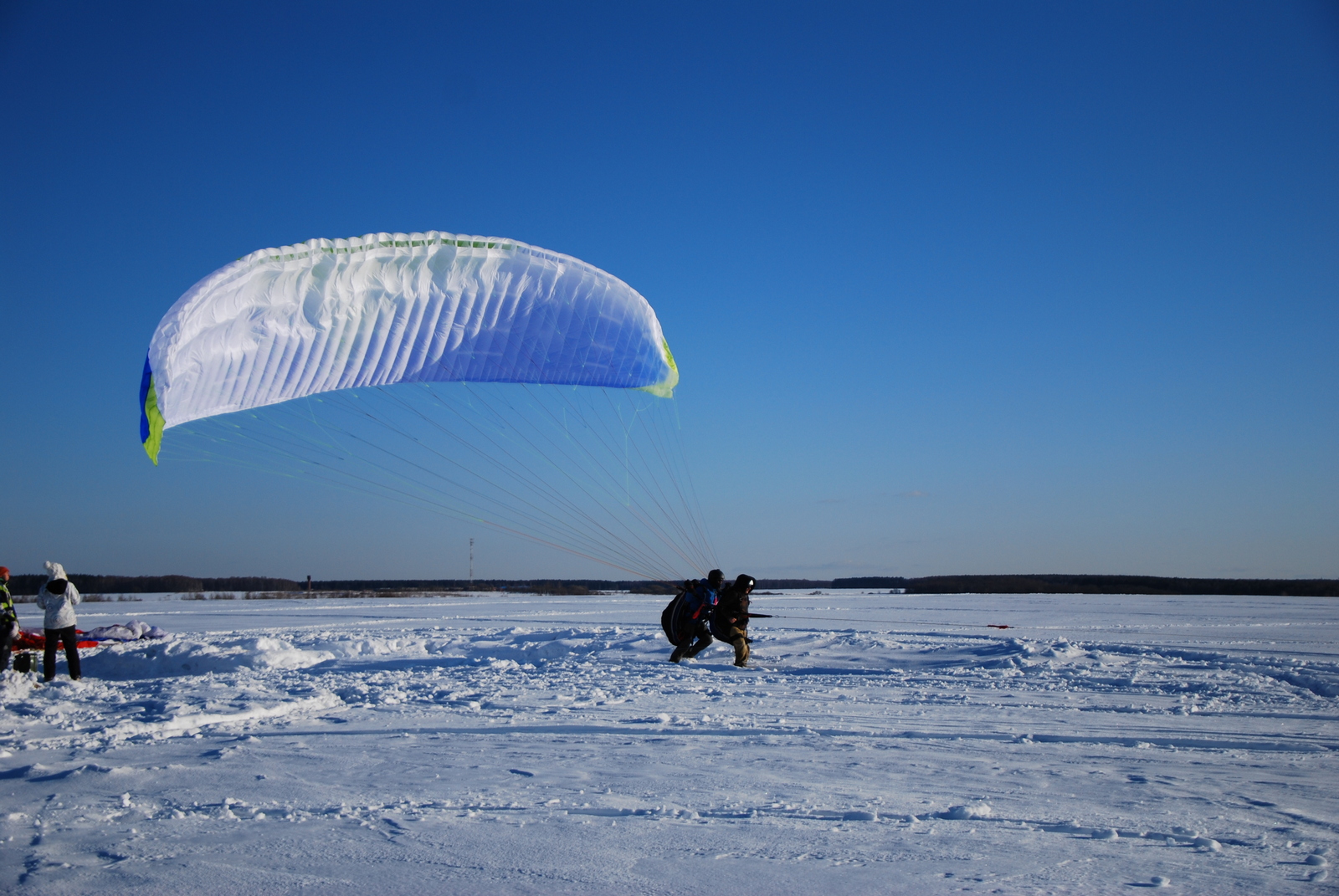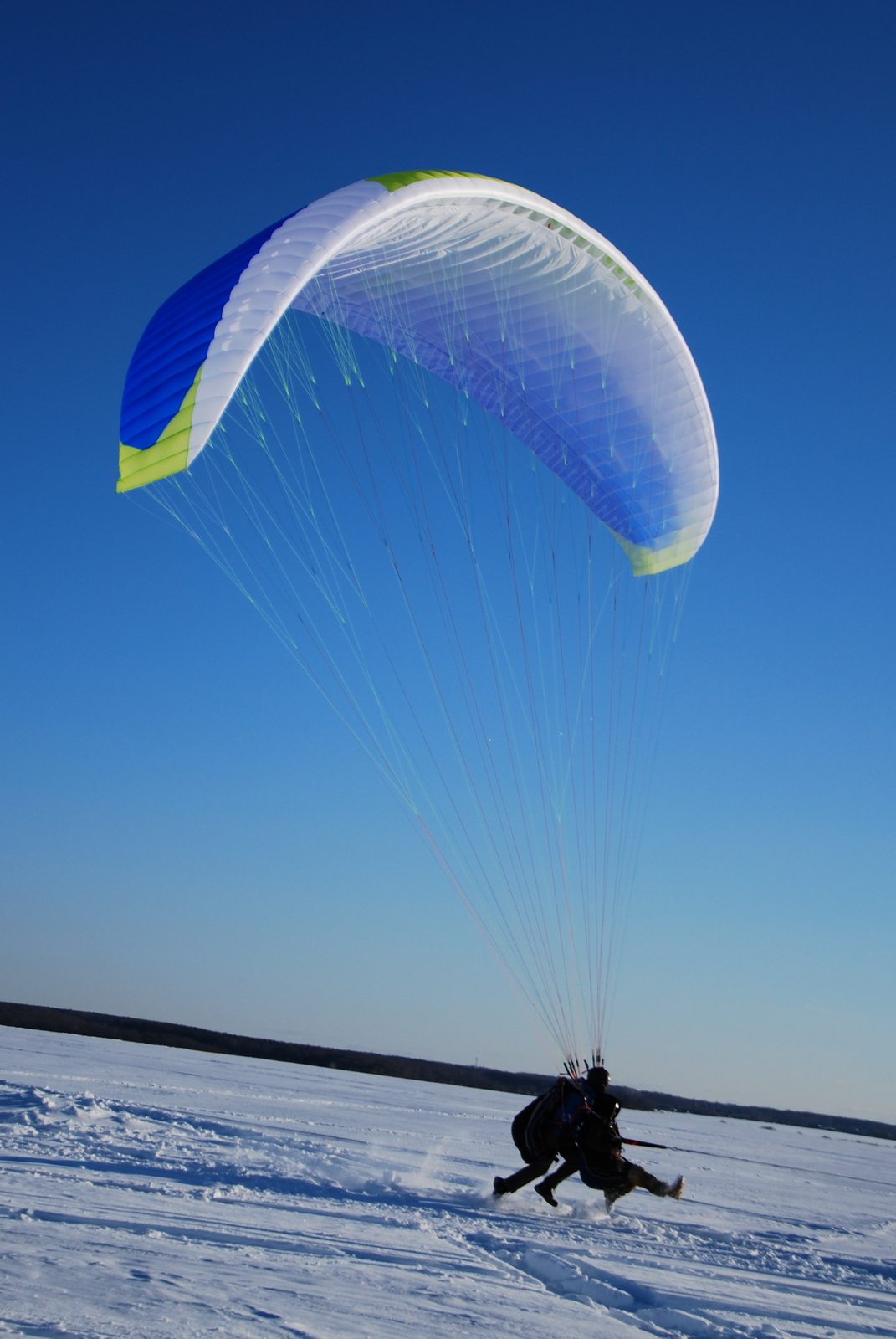Construction
S.E.A. already has its own style, clearly appreciable from the first contact with glider. The first thing differing S.E.A. wings from many others are softlinks instead of steel maillons: a rare option for tandem glider! Softlinks have the advantage of being cheaper, lighter and very reliable (no possibility of occasional unfolding which happens to maillons time up to time). The risers are made of wide and decent webbing: sobre, simplistic but very usable and not without original details. The trim webings are of very visible gray color, with the end loops made of contrasting yellow webbing. The brake handles are typical for S.E.A.: big, comfortable and neoprene-covered for better grip.
Unfortunately i had only a very small time window for testing this glider, so the canopy construction analysis has been made mostly by looking at the high quality fotos made during some short flights (thanks to my wife for foto session!). Reasonably high AR, lots of sections, specific S.E.A. wing shape with the ears slightly swept up — the look which is both ambitious and original. The 3D cut and unexpectedly high manufacturing quality result in a very clean and smooth leading edge which is rather appropriate for a high level solo wing. The in-depth analysis however reveals some small imperfections at ~20% of chord... but, come on, it's not a PWC gun, it's just a biplace!
Takeoff
Very good for no wind conditions and winch towing! It was most simple for me to compare Aeromaster with the DaVinci Duet recently test flown by me in similar conditions. The glider comes in flight position in a steady and reliable manner but behaves less pitch stable than Duet. It's desirable to apply some brakes avoiding a forward surge during takeoff. The good news are that Aeromaster tolerates very deep brake input, it's difficult to stall it occasionally during takeoff. Had a heavy passenger stuck in thick snow just at the moment when the glider came overhead, and, with lots of brakes applied and some extra winch thrust, we managed to take off! With lighter passengers running at reasonable speed, the takeof is a piece of cake. Steady pull on A risers, small portion of brakes after the wing comes in flight position, airborne.
Landing
Between good and very good. Having no wind at landing is a rather delicate situation while flying a biplace (especially with heavy passngers), an effective final braking is needed to ensure the smooth landing. Fortunately, it's not a problem for Aeromaster (at least if having the total flight weight below 160 kgs). Good swoop is desirable to build some excess of airspeed which will further be converted into a zero vertical speed touchdown (if you apply enough brakes and pull them for some time). With heavier passengers (the total flight weight around 200-210 kgs) the things are getting more complicated due to elevated brakes effort which makes the final pull less effective; but the only problem is that, in this case, it's difficult to bring the passenger to the ground without letting him gently contact the ground with his rear part.
The flight
The overall performance. For sure this Aeromaster has some XC ambition! The performance is rather high for a biplace wing. The sink rate at moderate wing loads is small, allowing to catch even the scrappy thermals. Forgot my vario but quickly discovered that i'm still able to soar! Great for XC, less great for commercial flying (where the short flying cycle is generally needed). Another Aeromaster's strong point is its ability to maintain reasonable sink rates even at decent bank angles (a sign of high glide). Didn't have a possibility to compare the Aeromaster with other biplaces in long straight glides, but it appears that this biplace has a good polar.
Control efficiency. Clearly below average but not yet the level of market leaders, being slightly below the level of DaVinci Duet and Sup'Air Sora. The Aeromaster has the most pleasant turn being loaded at 160 kilograms: in this case the brakes are reasonably light but very efficient. Compared to Duet, the Aeromaster is much more agile on bank, disliking the flat turns. Having a passenger aware of weigt shift and working together may provoke you to make some really nice, quick and ample wingovers. The non-pilot passengers, however, will not prevent you from doing the same if you really want to. The same for steep spirals: reaching -10 m/s of sink is easy. Compared to Duet again, the Aeromaster has slightly less efficient brakes but dislikes to turn flat, quickly building high bank angles and getting lots of airspeed. If you need a biplace for making you women passengers screaming aloud — take the Aeromaster, it will be a right choice!
Comfort and feedback. They always contradict each other, and, for Aeromaster, the balance of comfort and feedback is surely on the feedback side. Entering the small spring thermals produces some positive pitch and marked airspeed loss; leaving the core means an appreciable airspeed gain and some negative pitch. The canopy remains 100% "monobloc" during these games: not even a small sign of wobbling or snaking, no crisping sound of cloth. The brakes feedback is impressively high; the pitch and roll feedback are also very present. All these occasional evolutions are safe, rarely bringing the glider to the edge of collapse, but they may really impress some passengers. It's desirable to use a calmer biplace if you want to keep your passenger 100% comfortable all the time. But the same high level of feedback is very favourable for pedagogic tandem sessions, especially for learning someone to work in thermals. The passenger will have plenty of feedback and lots of brake efficiency.
Energy retention. Highly above average, especially in case of heavy passenger, but still acceptable from the point of view of passenger comfort, and well controllable by the pilot. This glider can conserve lots of airspeed and convert it into impressive pitches, so the too emotional passengers are better to be avoided. With heavy passengers, the final swoop allowes a soft landing even in no wind consitions — however this maneuver demands certain skills.
Conclusions
The holy grail of my paraglider testing is the glider temper: something difficult to describe by numbers but unique and intrinsic for each glider. As to Aeromaster, it definitely has a temper of its own! Surely it's not a "workhorse" for purely commercial flying. Okay, it has all what is needed for: good takeoff and soft landing. But the rest is rather specific: you still may gift your grandma a tandem flight using Aeromaster, but with some limitations including denial for flying in bumpy air and inducing ample maneuvers. Aeromaster is rather agile and sensitive to turbulence and pilot input and may produce strong emotions. Not so good for menthally fragile passengers, perfect for adrenaline addicts and learning young pilots to find and core their first thermals while flying a pedagogic tandem. Aeromaster is a rare example of "supercharged" biplace wing with sporty nature and XC ambition which, fortunately, does not harm the safety approved by EN B label. Personally i like it, others may like it less.
Strong points
- Good level of performance
- Good takeoff and landing in weak wind and no wind conditions (didn't try it in stronger wind)
Weak points
- Not found
Peculiarities
- High levels of feedback and energy retention
Special thanks
- Nikolai Solomko ( http://sea-wings.pro ) : glider, logistics
- Maria Vihlyaeva ( http://my-nebo.ru/ ) : tandem equipment, winch towing
Foto: I. Tarasova, A. Tarasov

